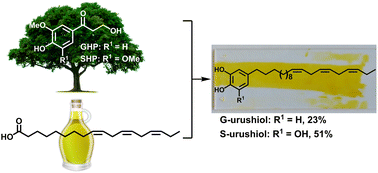Synthetic urushiols from biorenewable carbon resources: chemical conversion of enzymatic degradation products of wood lignin to an ancient yet future coating material†
Abstract
An artificial urushi material was developed by chemical transformations of phenylpropanoids available from enzymatic degradation of woody lignin, demonstrating the potential of renewable biomass in materials science and technology. The succeeding five-step organic synthesis brings about new urushiol analogs, which possess curing and coating properties, such as hardness, comparable to those of the precious natural urushi materials. The present study exemplifies the application of woody biomass to the synthesis of sustainable and high-performance coating materials.



 Please wait while we load your content...
Please wait while we load your content...